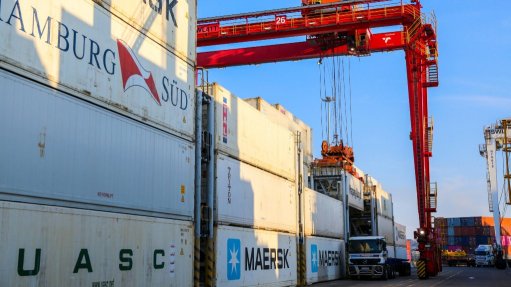New technology used to restore damaged pipes
Innovative technology has successfully been used in a rehabilitation project by pipe relining solutions provider Water Damage Services to restore corroded pipes at the Good Hope Centre, in Cape Town.
The technology uses compressed air to pull or push reinforced proxy into position to rehabilitate the inner infrastructure of corroded pipes. The process is nonintrusive, as it restores pipes from the inside, removing the need to excavate the building to gain access to the plumbing.
The technology, by innovative green technologies manufacturer NuFlow, is a long-term solution to restore pipes consisting of metal, iron, steel, plastic, concrete and fibreglass.
Water Damage Services is the NuFlow licensee for the Western Cape.
Water Damage Services public officer Jerome Gray tells Engineering News that the pipes were badly corroded and some were blocked with scale and rust build-up.
“Our structural liners replaced massive gaps where the pipes had completely disintegrated. Among these were multiple 90˚ bends, which were completely encased in structural concrete. Traditional pipe replacement would almost be impossible.”
He notes that mapping out the lines was difficult, since the building is old, but adds that, fortunately, the company used equipment, including sonde location, closed-circuit television and thermal imaging, as well as tracer gas, to locate the pipes,” he says.
The challenge, Gray says, was to accommodate the various pipe diameters, ranging from 80 mm to 160 mm diameters; however, Water Damages Services did make provision for transitional pipe-size changes.
Relining Process
Depending on the type of blockage and pipes, two processes would usually be considered.
For trenchless water pipe rehabilitation, pipes are first tested for any leakages and an abrading agent is air blasted through the pipe to remove all rust and corrosive particles.
An epoxy mixture is then blasted through the pipe with conditioned air to uniformly distribute the epoxy lining through the piping system, resulting in a relined, repaired pipe from the inside.
For trenchless drainpipe rehabilitation inspection, a camera will be sent down the pipe to identify blocked and damaged areas. The pipe is then cleaned with a cutting tool. A felt liner is saturated with epoxy and then pulled into place. Within the liner is a bladder. When the liner is in place, the bladder is inflated. The epoxy is left to cure, after which it is removed, leaving behind a structural pipe within a pipe.
Gray says no special maintenance is required, as the original corroded host pipe is now just a shell to hold the new seamless pipe within a pipe.
This reduces future blockages by 95%, as the seamless line prevents root intrusion and turbulence from causing blockages. This also creates a barrier between the corrosive metal pipe and the water that causes corrosion.
“Our US-based chemical engineers have accommodated for a 60- to 100-year life span, depending on the application, but since this technology is still new, we have only 20 years of data to officially look back on,” Gray says.
Many insurance companies repudiate claims for domestic and commercial dwellings on the grounds that the leaking pipes are pitted, he notes, but adds, however, that the technology offers a solution that will benefit insurance companies and their clients.
Water Damage Services is negotiating with insurance companies to offer this technology and has even acquired a miniature version of its relining rig that can fit into a door threshold.
The company is also in negotiations with local maritime engineering companies to reline oil rigs, the local harbour, the Waterfront and various other government establishments in the Western Cape.
Article Enquiry
Email Article
Save Article
Feedback
To advertise email advertising@creamermedia.co.za or click here
Comments
Press Office
Announcements
What's On
Subscribe to improve your user experience...
Option 1 (equivalent of R125 a month):
Receive a weekly copy of Creamer Media's Engineering News & Mining Weekly magazine
(print copy for those in South Africa and e-magazine for those outside of South Africa)
Receive daily email newsletters
Access to full search results
Access archive of magazine back copies
Access to Projects in Progress
Access to ONE Research Report of your choice in PDF format
Option 2 (equivalent of R375 a month):
All benefits from Option 1
PLUS
Access to Creamer Media's Research Channel Africa for ALL Research Reports, in PDF format, on various industrial and mining sectors
including Electricity; Water; Energy Transition; Hydrogen; Roads, Rail and Ports; Coal; Gold; Platinum; Battery Metals; etc.
Already a subscriber?
Forgotten your password?
Receive weekly copy of Creamer Media's Engineering News & Mining Weekly magazine (print copy for those in South Africa and e-magazine for those outside of South Africa)
➕
Recieve daily email newsletters
➕
Access to full search results
➕
Access archive of magazine back copies
➕
Access to Projects in Progress
➕
Access to ONE Research Report of your choice in PDF format
RESEARCH CHANNEL AFRICA
R4500 (equivalent of R375 a month)
SUBSCRIBEAll benefits from Option 1
➕
Access to Creamer Media's Research Channel Africa for ALL Research Reports on various industrial and mining sectors, in PDF format, including on:
Electricity
➕
Water
➕
Energy Transition
➕
Hydrogen
➕
Roads, Rail and Ports
➕
Coal
➕
Gold
➕
Platinum
➕
Battery Metals
➕
etc.
Receive all benefits from Option 1 or Option 2 delivered to numerous people at your company
➕
Multiple User names and Passwords for simultaneous log-ins
➕
Intranet integration access to all in your organisation


















